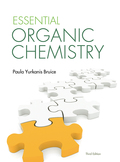
(a)
Interpretation: The diene and dienophile which are used to synthesize the given compound has to be determined.
Concept Introduction:
Diels-Alder reaction:
A conjugated diene reacts with a compound containing a carbon-carbon double bond is said to be Diels-Alder reaction. It is a cycloaddition reaction, where two reactants form a cyclic product.
Conformation of Diene:
S-Cis Conformer: The double bonds are cis about the single bond (s stands for single), in an s-cis conformer.
S-trans Conformer: The double bonds are trans- about the single bond (s stands for single) in an s-trans conformer.
Condition for Diels-Alder reaction:
The conjugate diene must be in an s-cis conformation because when it is in an S-trans conformation, C-1 and C-4 are too far apart to react with the dienophile in a concerted reaction.
(b)
Interpretation: The diene and dienophile which are used to synthesize the given compound has to be determined.
Concept Introduction:
Diels-Alder reaction:
A conjugated diene reacts with a compound containing a carbon-carbon double bond. It is a cycloaddition reaction, where two reactants form a cyclic product.
Conformation of Diene:
S-Cis Conformer: The double bonds are cis about the single bond (s stands for single), in an s-cis conformer.
S-trans Conformer: The double bonds are trans- about the single bond (s stands for single) in an s-trans conformer.
Condition for Diels-Alder reaction:
The conjugate diene must be in an s-cis conformation because when it is in an S-trans conformation, C-1 and C-4 are too far apart to react with the dienophile in a concerted reaction.
(c)
Interpretation: The diene and dienophile which are used to synthesize the given compound has to be determined.
Concept Introduction:
Diels-Alder reaction:
A conjugated diene reacts with a compound containing a carbon-carbon double bond. It is a cycloaddition reaction, where two reactants form a cyclic product.
Conformation of Diene:
S-Cis Conformer: The double bonds are cis about the single bond (s stands for single), in an s-cis conformer.
S-trans Conformer: The double bonds are trans- about the single bond (s stands for single) in an s-trans conformer.
Condition for Diels-Alder reaction:
The conjugate diene must be in an s-cis conformation because when it is in an S-trans conformation, C-1 and C-4 are too far apart to react with the dienophile in a concerted reaction.
Want to see the full answer?
Check out a sample textbook solution
Chapter 7 Solutions
EBK ESSENTIAL ORGANIC CHEMISTRY
- I need help with the followingarrow_forwardFor Raman spectroscopy/imaging, which statement is not true regarding its disadvantages? a) Limited spatial resolution. b) Short integration time. c) A one-dimensional technique. d) Weak signal, only 1 in 108 incident photons is Raman scattered. e) Fluorescence interference.arrow_forwardUsing a cell of known pathlength b = 1.25115 x 10-3 cm, a water absorption spectrum was measured. The band at 1645 cm-1, assigned to the O-H bending, showed an absorbance, A, of 1.40. a) Assuming that water density is 1.00 g/mL, calculate the water molar concentration c (hint: M= mole/L) b) Calculate the molar absorptivity, a, of the 1645 cm-1 band c) The transmitted light, I, can be written as I= Ioexp(-xb), where x is the absorption coefficient (sometimes designated as alpha), Io is the input light, and b is the cell pathlength. Prove that x= (ln10)*x*c. (Please provide a full derivation of the equation for x from the equation for I). d) Calculate x for the 1645 cm-1 bandarrow_forward
- For CARS, which statement is not true regarding its advantages? a) Contrast signal based on vibrational characteristics, no need for fluorescent tagging. b) Stronger signals than spontaneous Raman. c) Suffers from fluorescence interference, because CARS signal is at high frequency. d) Faster, more efficient imaging for real-time analysis. e) Higher resolution than spontaneous Raman microscopy.arrow_forwardDraw the major product of the Claisen condensation reaction between two molecules of this ester. Ignore inorganic byproducts. Incorrect, 5 attempts remaining 1. NaOCH3/CH3OH 2. Acidic workup Select to Draw O Incorrect, 5 attempts remaining The total number of carbons in the parent chain is incorrect. Review the reaction conditions including starting materials and/or intermediate structures and recount the number of carbon atoms in the parent chain of your structure. OKarrow_forwardUsing a cell of known pathlength b = 1.25115 x 10-3 cm, a water absorption spectrum was measured. The band at 1645 cm-1, assigned to the O-H bending, showed an absorbance, A, of 1.40. a) Assuming that water density is 1.00 g/mL, calculate the water molar concentration c (hint: M= mole/L) b) Calculate the molar absorptivity, a, of the 1645 cm-1 band c) The transmitted light, I, can be written as I= Ioexp(-xb), where x is the absorption coefficient (sometimes designated as alpha), Io is the input light, and b is the cell pathlength. Prove that x= (ln10)*x*c d) Calculate x for the 1645 cm-1 bandarrow_forward
